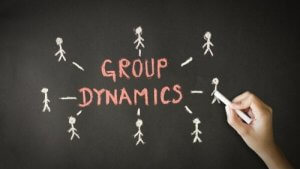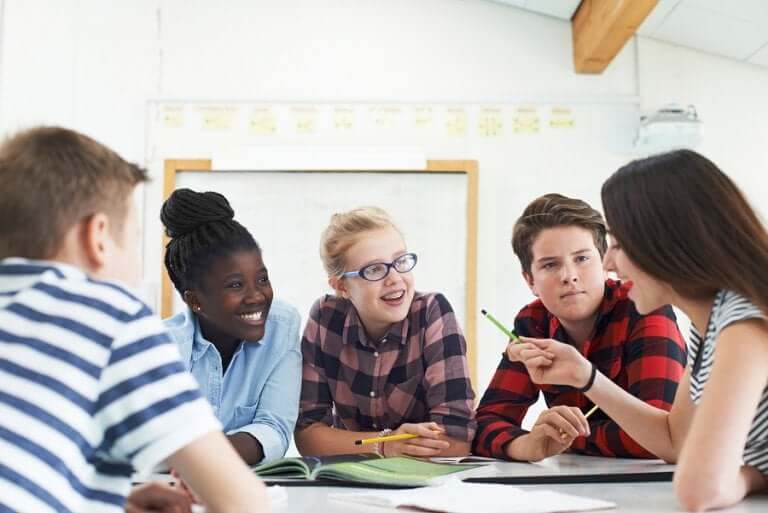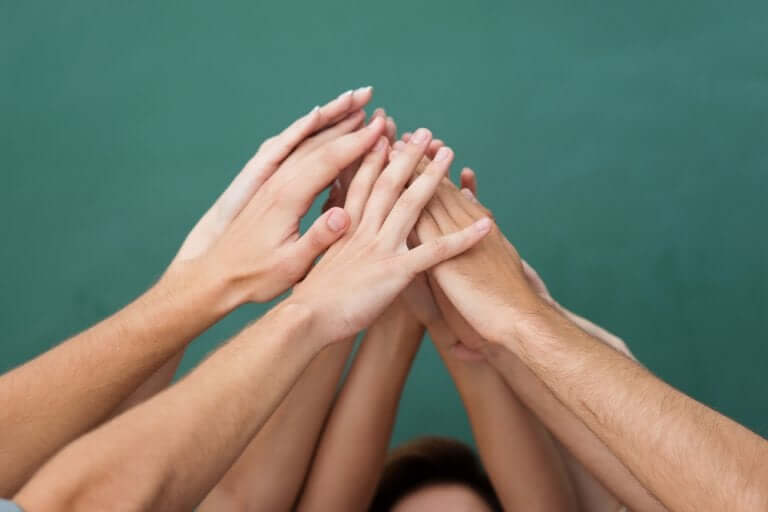The Benefits of Group Dynamics for Adolescents

Adolescence is a time of great changes, all of which are necessary on the road to becoming an adult. In this article we’ll take a close look at group dynamics for adolescents, and how they can help them in their development.
To understand how group dynamics work for adolescents, we must first clarify the concepts of puberty and adolescence, and the differences between them.
On the one hand, puberty is a series of biological, physical, morphological, hormonal, and psychosexual changes. These take place in order to transform the infant body into an adult body capable of reproduction.
Adolescence, on the other hand, is the process of transition from childhood to adulthood over a period of several years. It’s a stage during which a number of changes take place.
These aren’t only the factors mentioned above, but also intellectual, psychological and social factors. It is these factors that group dynamics for adolescents work on.
What are group dynamics?
Group dynamics refer to systematized methods or procedures that aim to organize a group of people and develop them as individuals.
They’re very motivating techniques that, when applied in a group situation, stimulate them and help them learn on several different levels. As a result, they work on their potential and develop their effectiveness.
In this way, a group working with these dynamics can achieve their objectives and be more productive. In addition, they can achieve greater cohesion and an improved sense of teamwork.

Group dynamics for adolescents
Group dynamics for adolescents can be useful both in schools and in any other institution or youth organization, association or center. It’s important to make sure that the dynamic being used is going to achieve objectives related to the particular groups of adolescents and its specific characteristics. It must have a specific purpose.
In addition, other factors must be considered, such as social, financial, cultural, institutional, among others. All things said, group dynamics for adolescents should be aimed at developing meaningful learning in every area. Their purpose should be to help them reflect and mature.
This learning should be related to:
- Socialization
- Creativity
- Communication
- Self-esteem
- Responsibility
- Autonomy
- Conflict resolution
- Participation
- Expressivity
- Management of emotions
Different dynamics
Currently, there is a great variety of group dynamics for adolescents, classified according to their own particular objectives. They can also be very varied in their characteristics, duration, activities, and complexity.
There are, in the first place, dynamics whose objective is to “break the ice.” In these activities, group members introduce themselves to each other and get to know each other better.
For example, there’s a dynamic called “Starting Point.” In this activity, each member of the group introduces himself by answering a brief questionnaire with questions such as their name, favorite color, a skill they possess, a shortcoming, and a limitation and virtue in their lives.
We find other dynamics whose objectives are to reflect on communication within groups. Many of them attempt to discover what issues and factors can cause conflicts, and how to resolve them. On this topic, there are useful dynamics such as the Broken Telephone, or the Sociogram.

On the other hand, there are dynamics such as Brainstorming or a Symposium. These help in the distribution of tasks and responsibilities in order to achieve a better organization and consensus within the group.
There are also group dynamics for teenagers whose objective is to resolve conflicts and change behavior.
One example is the Six Thinking Hats activity, invented by Edward de Bono, and there are other types of role-playing too. These dynamics work on aspects such as empathy, putting oneself in the place of others, and in considering different perspectives in order to resolve a particular problem or situation.
Final considerations
Any group dynamics for adolescents will always be very positive, as they help to develop learning related to social, moral and axiological behavior and attitudes. These are fundamental concepts in order to achieve a correct evolution and maturity in adolescents.
In short, it’s essential to create situations where young people are able to reflect on their behavior and its consequences.
Adolescence is a time of great changes, all of which are necessary on the road to becoming an adult. In this article we’ll take a close look at group dynamics for adolescents, and how they can help them in their development.
To understand how group dynamics work for adolescents, we must first clarify the concepts of puberty and adolescence, and the differences between them.
On the one hand, puberty is a series of biological, physical, morphological, hormonal, and psychosexual changes. These take place in order to transform the infant body into an adult body capable of reproduction.
Adolescence, on the other hand, is the process of transition from childhood to adulthood over a period of several years. It’s a stage during which a number of changes take place.
These aren’t only the factors mentioned above, but also intellectual, psychological and social factors. It is these factors that group dynamics for adolescents work on.
What are group dynamics?
Group dynamics refer to systematized methods or procedures that aim to organize a group of people and develop them as individuals.
They’re very motivating techniques that, when applied in a group situation, stimulate them and help them learn on several different levels. As a result, they work on their potential and develop their effectiveness.
In this way, a group working with these dynamics can achieve their objectives and be more productive. In addition, they can achieve greater cohesion and an improved sense of teamwork.

Group dynamics for adolescents
Group dynamics for adolescents can be useful both in schools and in any other institution or youth organization, association or center. It’s important to make sure that the dynamic being used is going to achieve objectives related to the particular groups of adolescents and its specific characteristics. It must have a specific purpose.
In addition, other factors must be considered, such as social, financial, cultural, institutional, among others. All things said, group dynamics for adolescents should be aimed at developing meaningful learning in every area. Their purpose should be to help them reflect and mature.
This learning should be related to:
- Socialization
- Creativity
- Communication
- Self-esteem
- Responsibility
- Autonomy
- Conflict resolution
- Participation
- Expressivity
- Management of emotions
Different dynamics
Currently, there is a great variety of group dynamics for adolescents, classified according to their own particular objectives. They can also be very varied in their characteristics, duration, activities, and complexity.
There are, in the first place, dynamics whose objective is to “break the ice.” In these activities, group members introduce themselves to each other and get to know each other better.
For example, there’s a dynamic called “Starting Point.” In this activity, each member of the group introduces himself by answering a brief questionnaire with questions such as their name, favorite color, a skill they possess, a shortcoming, and a limitation and virtue in their lives.
We find other dynamics whose objectives are to reflect on communication within groups. Many of them attempt to discover what issues and factors can cause conflicts, and how to resolve them. On this topic, there are useful dynamics such as the Broken Telephone, or the Sociogram.

On the other hand, there are dynamics such as Brainstorming or a Symposium. These help in the distribution of tasks and responsibilities in order to achieve a better organization and consensus within the group.
There are also group dynamics for teenagers whose objective is to resolve conflicts and change behavior.
One example is the Six Thinking Hats activity, invented by Edward de Bono, and there are other types of role-playing too. These dynamics work on aspects such as empathy, putting oneself in the place of others, and in considering different perspectives in order to resolve a particular problem or situation.
Final considerations
Any group dynamics for adolescents will always be very positive, as they help to develop learning related to social, moral and axiological behavior and attitudes. These are fundamental concepts in order to achieve a correct evolution and maturity in adolescents.
In short, it’s essential to create situations where young people are able to reflect on their behavior and its consequences.
All cited sources were thoroughly reviewed by our team to ensure their quality, reliability, currency, and validity. The bibliography of this article was considered reliable and of academic or scientific accuracy.
- Johnson, B. A. N. Y. (1981). La dinámica de grupo en la educación. Aguilar. l980.
- Vivas, P., Rojas Arredondo, J., y Torres Virgili, M. E. (n.d.). Dinámica de grupos. Universitat Oberta de Catalunya. Material docente de la UOC. Recuperado de https://www.psyciencia.com/wp-content/uploads/2012/11/DINA_MICA-DE-GRUPOS.pdf
This text is provided for informational purposes only and does not replace consultation with a professional. If in doubt, consult your specialist.








